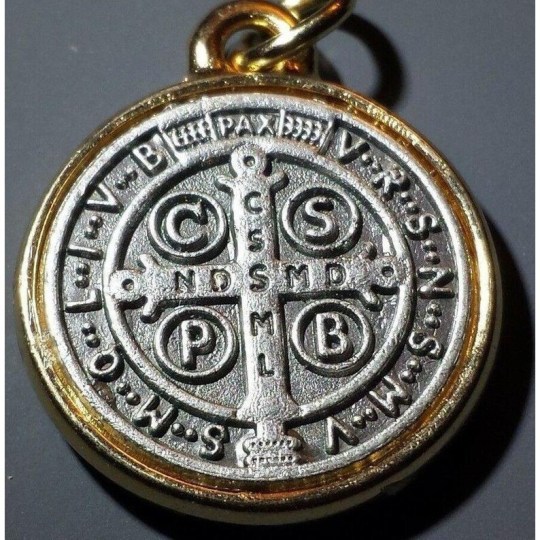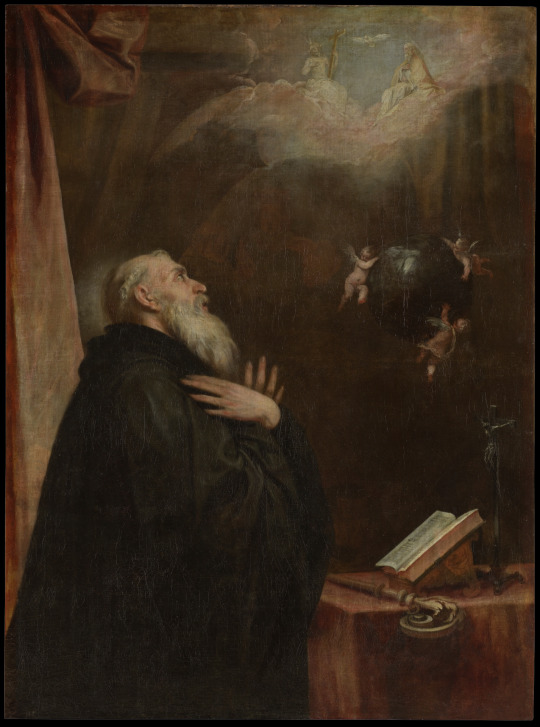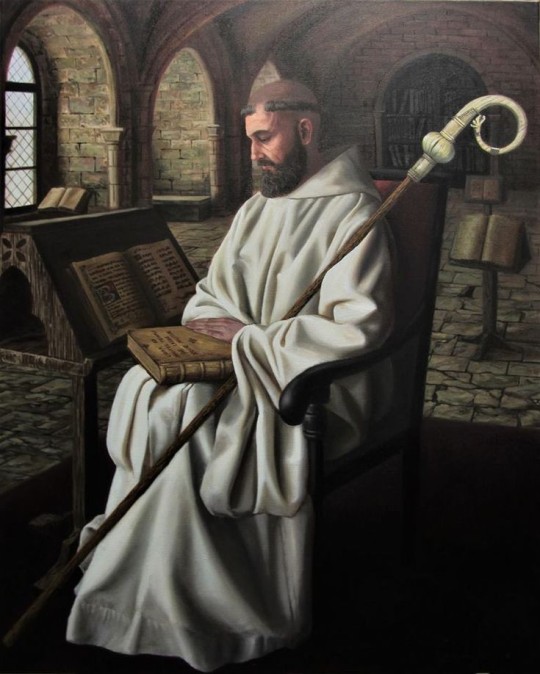#Benedict of Nursia
Text

64 notes
·
View notes
Text

0 notes
Text

1 note
·
View note
Text

THE DESCRIPTION OF SAINT BENEDICT OF NURSIA
The Father of Western Monasticism
Feast Day: July 11
"Saint Benedict to you we turn.
The secrets of God’s grace to learn.
O, guide us by your wise decrees,
that God alone we seek to please."
-from the Hymn to Saint Benedict by Fr. Benildus Maramba
The founder of the Benedictine Order and the famed Father of Western Monasticism, was born at Norcia, Umbria in Italy, on March 2, 480, during the reign of Flavius Odoacer, the king of Italy. He was the son of a Roman noble. A tradition which Bede accepts makes him a twin with his sister Scholastica. If 480 is accepted as the year of his birth, the year of his abandonment of his studies and leaving home would be about 500. Shocked by the degenerate life of his fellow students in Rome, at the age of 20, he, along with his old nurse, withdrew to the mountain of Subiaco.
One day, the devil brought before his imagination a beautiful woman he had formerly known, inflaming his heart with strong desire for her. Immediately, Benedict stripped off his clothes and rolled into a thorn-bush until his body lacerated. Thus, through the wounds of the body he cured the wounds of his soul.
Invited to become the abbot of a group of notorious monks living in Vicovaro, he accepted the position; but the monks disagreed with his strict rules and tried to poison him. As he made the sign of the cross, the chalice containing the poisoned wine broke into pieces, and the plot was discovered. Thus he left the group, and went back to Subiaco.
There, he lived in the neighborhood a priest called Florentius, who moved by envy, tried to ruin him. Having failed by sending him poisonous bread, he tried to seduce his monks with some prostitutes. To avoid further temptations, in 530, Benedict left Subiaco to open a new Benedictine monastery at Monte Cassino.
Following the golden rule of 'Ora et Labora - Pray and Work', the monks each day devoted eight hours to prayer, eight hours to sleep, and to eight hours to manual work, sacred reading, or works of charity. During the invasion of Italy, Totila (originally named Baduila), the king of the Goths, ordered a general to wear his kingly robes and to see whether Benedict would discover the truth. Immediately, Benedict detected the impersonation, and Totila came to pay him due respect.
According to tradition, Benedict believed to have struck with a fever. Knowing that his hour was approaching, he summoned monks to pray by his side and said: 'We must have an immense desire to go to heaven!'
Benedict died as his brother monks raised his arms in one final prayer as he passed from this life at Monte Cassino on March 21, 547 AD at the age of 67, not long after his twin sister Scholastica died, and was buried in the same place as his sister.
Canonized a saint by Pope Honorius III in 1220, Benedict was named patron protector of Europe by Pope Paul VI in 1964. St. John Paul II declared him co-patron of Europe in 1980 along with Cyril and Methodius, and furthermore, he is the patron of speleologists and spelunkers. So far, the Benedictines have given to the Church 50 Popes, 7,000 Bishops, and 40,000 Saints.
Benedict is the patron of Heerdt in Germany, Norcia in Italy, San Beda University, and the Institute of Christ the King Sovereign Priest in Gricigliano, Italy. He had two major shrines - in the abbey of Monte Cassino, and in Saint-Benoît-sur-Loire, near Orléans, France.
#random stuff#catholic#catholic saints#saint benedict#benedict of nursia#benedictines#order of saint benedict#western monasticism#san benito
1 note
·
View note
Text

Alonso Cano (Spanish, 1601-1667)
Saint Benedict's Vision of the Globe and the three Angels, ca.1658-60
Museo Nacional del Prado
#my patron saint#saint benedict#saint benedict of nursia#art#fine art#european art#classical art#europe#european#oil painting#fine arts#europa#mediterranean#spanish art#spain#spanish#classic art#st benedict#alonso cano#espana#st benedict od nurisa#1600s#christentum#christian#christianity#catholic#catholicism#roman catholic#saint#hispanic
40 notes
·
View notes
Photo

Today we celebrate the Venerable Benedict of Nursia, the founder of Western Monasticism. At the age of fourteen, Benedict was unsettled by the life of sin of the society around him that he decided to devote himself to the monastic life. He eventually began his own monastery where he developed his own monastic rule which has been passed down from generation to generation and is still practiced today by the Western Benedictine monasteries. This rule he believed to be a way of attaining perfection, or Theosis in this earthly life. Having lived a life of purity and prayer, the Lord granted him the gifts of wonderworking and prophesy before his peaceful repose. May he intercede for us always + #saint #benedict #stbenedict #benedictus #nursia #italy #rome #monk #monastic #monasticrule #rule #west #western #westernmonastery #monastery #prayer #faith #love #orthodox #saintoftheday (at Monte Cassino) https://www.instagram.com/p/Cpvo5lUDebr/?igshid=NGJjMDIxMWI=
#saint#benedict#stbenedict#benedictus#nursia#italy#rome#monk#monastic#monasticrule#rule#west#western#westernmonastery#monastery#prayer#faith#love#orthodox#saintoftheday
27 notes
·
View notes
Text

A nice image of St. Benedict of Nursia. I don't know who the artist is.
#traditional catholicism#traditional catholic images#traditional catholic modern art#traditional catholic saints#traditional catholic saints images#st. benedict of nursia#founder of the benedictine order#traditional catholic father's and doctors of the church
16 notes
·
View notes
Text
SAINT OF THE DAY (July 11)

On July 11, the Catholic Church celebrates the feast of Saint Benedict of Nursia, the sixth-century abbot who gave Christian monasticism its lasting foundation in Western Europe.
For his historic role as the “Father of Western Monasticism,” St. Benedict was declared a co-patron of Europe (along with Saints Cyril and Methodius).
St. Benedict is also the patron saint of Pope Benedict XVI's pontificate.
In a 2005 general audience, Pope Benedict XVI said St. Benedict was a “powerful reminder of the indispensable Christian roots of Europe."
He cited the monk's instruction to “prefer nothing to the love of Christ and asked his intercession to help us keep Christ firmly at the heart of our lives.”
Born to upper-class parents in modern-day Italy during the year 480, Benedict was sent to Rome to study the humanities.
However, he soon became disgusted with the loose morals that prevailed among the students. Withdrawing from the city, he lived briefly with a group of monks, then as a hermit.
The young man spent three years in solitude, facing and overcoming severe temptations through prayer and asceticism.
Only after doing so did he have the confidence to emerge as an organizer of monastic communities. His first monasteries were established in the Anio valley outside Subiaco.
Benedict's monasteries in Subiaco became centers of education for children, a tradition which would continue in the order during his lifetime and beyond.
His monastic movement, like its forebears in the Christian East, attracted large numbers of people who were looking to live their faith more deeply.
During 529, Benedict left Subiaco for Monte Cassino, 80 miles south of Rome.
The move was geographically and spiritually significant, marking a more public emergence of the Western monastic movement.
Benedict destroyed a pagan temple atop the mountain and built two oratories in its place.
It was most likely at Monte Cassino that the abbot drew up a rule of life, the famous “Rule of St. Benedict,” which emphasised prayer, work, simplicity, and hospitality.
Though known as a rule for monks, it is addressed to all those who seek “to do battle for Christ the Lord, the true King.”
Benedict's life was marked by various intrigues and miraculous incidents, which were described in his biography written by Pope St. Gregory the Great.
One of the most remarkable was his meeting in 543 with Totila, King of the Goths, in which the abbot rebuked the king's lifestyle and prophesied his death.
St. Scholastica, Benedict's sister, also embraced religious life as a nun. She most likely died shortly before him, around the year 543.
In his final years, the abbot himself had a profound mystical experience, which is said to have involved a supernatural vision of God and the whole of creation.
Around the age of 63, Benedict suffered his final illness. He was carried into the church by his fellow monks, where he received the Eucharist for the last time.
Held up by his disciples, he raised his hands in prayer for the last time, before dying in their arms.
Although his influence was primarily felt in Western Europe, St. Benedict is also celebrated by the Eastern Catholic churches and Eastern Orthodox Christians on March 14.
#Saint of the Day#Saint Benedict of Nursia#Father of Western Monasticism#Rule of St. Benedict#Saint Scholastica
3 notes
·
View notes
Photo

San Benedetto Giuseppe Labre, 1795
Antonio Cavallucci
#cavallucci#antonio cavallucci#benedict joseph labre#saints#radiant beauty#people who are homeless#st. benedikt josef labre#patron saints#homelessness#depression#mental illness#bipolar#st. benedict joseph labre#monastic#monasticism#st. benedict of nursia#art
5 notes
·
View notes
Text

14 martie: Sfântul Cuvios Benedict de Nursia
Sfântul Cuvios Benedict, fondatorul vieții monahale occidentale, s-a născut în orașul Nursia, în preajma anului 480. La vârsta de 14 ani, părinții sfântului l-au trimis la Roma, pentru studii. Tulburat de imoralitatea din jurul său, a decis să se devoteze unui altfel de trăi.
https://www.diane.ro/2024/03/14-martie-sfantul-cuvios-benedict-de.html
0 notes
Quote
Without doubt Christian asceticism, both outwardly and in its inner meaning, contains many different things. But it has had a definitely rational character in its highest Occidental forms as early as the Middle Ages, and in several forms even in antiquity. The great historical significance of Western monasticism, as contrasted with that of the Orient, is based on this fact, not in all cases, but in its general type. In the rules of St. Benedict, still more with the monks of Cluny, again with the Cistercians, and most strongly the Jesuits, it has become emancipated from planless otherworldliness and irrational self-torture. It had developed a systematic method of rational conduct with the purpose of overcoming the status naturæ, to free man from the power of irrational impulses and his dependence on the world and on nature. It attempted to subject man to the supremacy of a purposeful will, to bring his actions under constant self-control with a careful consideration of their ethical consequences. Thus it trained the monk, objectively, as a worker in the service of the kingdom of God, and thereby further, subjectively, assured the salvation of his soul.
Max Weber, The Protestant Ethic
0 notes
Text

Saint Scholastica
480 - 542
Feast Day: February 10
Patronage: convulsive children, nuns, invoked against storms and rain
St. Scholastica, born in Italy, was the twin sister of Benedict of Nursia. Scholastica was dedicated to God from a young age. The most commonly told story about her is that she would, once a year, go and visit her brother at a place near his abbey, and they would spend the day worshiping together and discussing sacred texts and issues. Three days after their last visit Benedict saw his sister's soul leaving the earth and ascending to heaven in the form of a shining white dove.
Prints, plaques & holy cards available for purchase here: (website)
38 notes
·
View notes
Text

~The Rule of Benedict~
The Rules of St. Benedict was created by Benedict of Nursia OSB as a way to help teach his monks and nuns how to fulfill a basic life of following Christ. This guide is still followed by Benedictine monastery and covenant today. St. Benedict taught that stability is required to help follow a life through Christ, you must balance your work, prayer, study, and leisure.
🎀 Prayer
Benedict saw prayer as a foundation to the monastic life and calling, but also for non-monastics. He valued the process of communal prayer each day as well as silent pray and meditation.
🎀 Work
Not only was paid employment seen as important, but also work within faithful communities. St. Benedict saw work as a value and to bring dignity to each human being. The work must honor God.
🎀 Study
Reading the holy scripture, reading the rule, reading works of wisdom, or studying with others to strengthen our spirituality is important.
🎀 Hospitality
Invite strangers into your lives but also stay close to those already within your lives. Welcome each person as Christ himself and having the right approach to one another, is the key to a healthy sense of hospitality.
🎀 Renewal
Keeping a sabbath, gaining interests that remind us of the presence of God, or taking time to appreciate the beauty of our daily lives is a great way to have renewal. Remember that our lives are centered on Christ and that God is the ultimate center of the rule of life.
#folk catholicism#catholic witch#christian witch#godlovesyou#god#catholic#witchcraft#witchy#jesuschrist#st benedict#saints#catholiscism#boost
14 notes
·
View notes
Text






HAPPY BIRTHDAY to Desi Arnaz, Benedict of Nursia, Moe Berg, Ed Bournemann, Dale Bozzio, Larry Carlton, Karen Carpenter, John Cowsill, Daniel Craig, John Cullum, Eddie “Lockjaw” Davis, Maxwell Street, Jimmy Davis, Becky G, Rory Gallagher, John Gardner, Mikhail Gorbachev, Laird Hamilton, Sam Houston, Bryce Dallas Howard, John Irving, Jennifer Jones, Léon Jongen, Jon Bon Jovi, Orrin Keepnews, the 1933 film KING KONG, Papa Lightfoot, BarBara Luna, Madonna’s 1989 single “Like a Prayer,” Chris Martin, Gates McFadden, drummer-producer Tony Meehan (The Shadows), Method Man, Wolfgang Muthspiel, Lauraine Newman, Jay Osmond, Ethan Peck, Elvis Presley’s 1956 single “Lawdy Miss Clawdy,” Luke Pritchard (The Kooks), Dottie Rambo, Red Saunders, Dennis Seaton (Musical Youth), Shostakovich’s 14th Symphony (1969), Bedřich Smetana, the 1995 musical SMOKY JOE’S CAFÉ, Ludovico Spontoni, the 1965 film SOUND OF MUSIC, composer-trumpeter Derek Watkins (James Bond films), Kurt Weill, Tom Wolfe, "Théo" Ysaÿe, and the creative provocateur, poet, and singer-songwriter Lou Reed. He was the principal songwriter for The Velvet Underground and his solo career spanned 5 decades.
Velvet Underground were not commercially successful but are now regarded as one of the most influential bands in the history of rock. Brian Eno said that everyone who heard the first VU album wanted to start a band. Reed had a deadpan voice that, for me, required forgiveness as singers go (though he did step up on occasion, particularly when he sung with The Blind Boys on THE RAVEN album). Eventually I connected with his noir fiction, transgressive “eyewitness reporting” lyrics and songcraft. He neither approved or disapproved of the subjects he sang about and, in the end, he just wanted to write catchy rock’n’roll. Over the years I’ve performed at least 6 Reed/VU songs—recording 2: “What Goes On” and “Sunday Morning,” on which I was joined by members of The Badlees (who did a splendid job in one afternoon). Reed himself commended our cover and promoted it on his website in the mid-90s. HB and RIP Lou.
#loureed #velvetunderground #sundaymorning #singersongwriter #bretalexander #thebadlees #blindboysofalabama #raven #edgarallenpoe #noirfiction #poet #guitarist #eyewitnessreport #johnnyjblair #singeratlarge #birthday
#johnny j blair#singer songwriter#music#singer at large#san francisco#pop rock#Lou Reed#Velvet Underground#birthday#The Badlees#noir fiction#Bandcamp
8 notes
·
View notes
Text

THE DESCRIPTION OF SAINT SCHOLASTICA
The Twin Sister of Saint Benedict
Feast Day: February 10
"Humility is the foundation of all virtues."
Scholastica was born circa 480 AD in Nursia, Umbria, Italy, of wealthy parents (Anicius Eupropius and his wife Claudia Abondantia Reguardati).
After her brother Benedict had gone to Monte Cassino, she settled in the nearby Plombariola, ruling a community of nuns. She visited Benedict once a year in a small house near the monastery.
One day after dinner, Scholastica asked her twin brother to remain a little longer, but he refused. Thus, she joined her hands and invoked the help of the Lord, who sent a violent storm, so that neither Benedict nor his companions could return home.
Benedict exclaimed: 'May God forgive you, sister; what have you done?'
Scholastica answered: 'I asked a favor of you, and you refused it; I asked it of God, and he has granted it.'
Benedict was therefore forced to comply with her request, and to spend the night talking about holy things and eternal happiness. The next morning they parted ways, and three days later, Scholastica passed away on February 10, 543 AD near Monte Cassino.
Benedict was at that time alone in his cell absorbed in prayer, when, lifting his eyes, he saw his sister's soul ascending to heaven as a dove. Filled with joy, he thanked God and sent some monks to bring his twin sister's body to his monastery, and laid it in the tomb he had prepared for himself.
It was the year 547 AD, and Benedict followed her soon after.
#random stuff#catholic#catholic saints#benedictines#order of saint benedict#scholastica#scholastica of nursia#escolástica#escolástica de nursia
46 notes
·
View notes
Text
“We descend by self-exaltation and ascend by humility.”
- St. Benedict of Nursia
99 notes
·
View notes